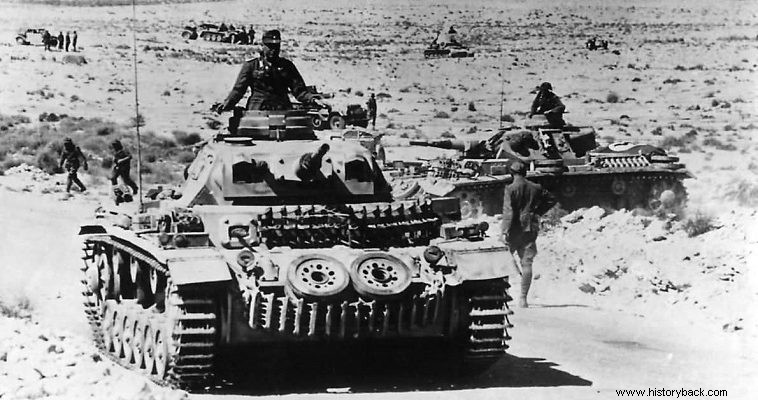
As soon as they set foot on African soil, the first units of the Afrika Korps, led by the stormy Rommel, went on the offensive, easily and quickly regaining ground that had just as easily and quickly been lost by their Italian allies. Their success was due, however, to the surprise and the bad arrangement and dispersion of the British forces.
The first major battle of the Afrika Korps was fought at Tobruk in April 1941 and was crowned with failure, as Rommel threw insufficient forces into the battle. Due to insufficient training in the desert environment, during the night, the raiding forces lost their orientation, got mixed up and gave the garrison an opportunity to repel them. The losses from this failure reached 600 dead, wounded and missing.
A new British offensive followed (Operation Crusader), in November 1941. In one of the battles fought then, the organic infantry of the 15th Panzer Division (MPa), reinforced by the engineer battalion of the same division and an anti-tank artillery, without artillery support or tanks, broke through the British defenses, up to the artillery positions, repulsed all enemy counterattacks, destroying many enemy tanks and overpowered two artillery companies and captured 600 British.
At the end of May 1942 the Afrika Korps returned to Tobruk and this time they captured it, giving Rommel his baton. The Afrika Korps then followed the retreating British, who fortified themselves at the location of El. Alamein.
His exhausted men's attempt to break through the reinforced British failed and when they met the enemy counterattack, the Axis front collapsed. In the meantime the Allies had landed and occupied French North Africa and were marching towards Tunisia, to the south of Rommel.
The Afrika Korps retreated, step by step, towards Tunisia, fiercely fighting the pursuing 8th Army. Rommel even attempted to counterattack at one point, but failed, just as he failed to hold on to the Mareth Line, the last strong defensive location before Tunisia. A few months later it was all over. The heroic units of the Afrika Korps laid down their arms, but left the legend alive.
The Divisions
The 15th Panzer Division
The 15th Infantry Division, in June 1941, participated in the battles against the British, repelling the latter's attacks (Operation "Brevity", Operation "Battleaxe"), while it particularly distinguished itself in November 1941, during Operation "Crusader", achieving brilliant results against the British, but also existing very serious losses. As a result of these losses, she was withdrawn from the battle line, until her reconstruction could be achieved.
In January 1942, reinforced with men and tanks, he took part in Rommel's successful counter-offensive, which resulted in the recapture of Benghazi. In May of the same year, he took part in the Battle of Gazala and the capture of Tobruk. He then took part in the pursuit of the retreating British, up to the line of El Alamein.
Between 1 July and 2 September, the 15th Infantry Division took part in the fruitless attacks on the El Alamein site and the Battle of Alam al Halfa. In the second battle of El Alamein the division was destroyed. Its remains retreated to Tunisia. There he reorganized and participated in the fierce German counter-attacks against the British, as well as the Greeks of the Holy Company (Battle of Ksar Rilan).
However, all counterattacks were repelled and gradually, until May 1943, the 15th Army, like the other German forces in Tunisia, were forced to lay down their arms.
The 21st Panzer Division
The 5th Light Division, later the 21st Infantry Division, also took part in all Afrika Korps operations and particularly distinguished itself in the fighting around Tobruk. After the defeat at El Alamein he retreated to Tunisia.
There she took part in the last successful German offensive in Africa, at Kasserine, where her veteran men had no difficulty in getting the better of the inexperienced Americans. This success was also the swan song of the 21st Army, which was finally forced to surrender on May 13, 1943, after the collapse of the Axis front in Tunisia.
The 90th Light Infantry Division (LIP)
The 90th NTUA fought excellently in all battles, suffering heavy losses. In the summer of 1942 the 90th NTUA was left with 1,600 fighting men. After the defeat at El Alamein it was reorganized in Tunisia, now numbering 5,700 men. There it finally surrendered, on May 12, after the collapse of the Axis front. Its last and longest-serving commander was Lieutenant General Theodor, Count von Sponeck, who commanded it from September 22, 1942 until the end.
The 164th Light Infantry Division
The 164th NTUA received its baptism of fire in the first battle of El Alamein. After the final defeat at El Alamein, in October 1942, he assumed rearguard duties, suffering very heavy losses. He reorganized in Tunisia and fought heroically in the Battle of the Mareth Line. By April 1943 he no longer owned a single vehicle. Surrendered May 13, 1943.
The captured men of the Afrika Korps were released in 1946-47, following a de-Nazification programme, which they attended.
